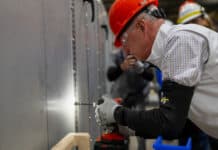
The construction industry is experiencing an amazing evolution. New and innovative technology is being infused at a rapidly growing rate. Building information modeling (BIM) and integrated building life cycle management are emerging processes. Sustainable development and green building are in their learning curve phases in the industry. New government incentives, new products, new costs, and new expectations bring new uncertainties, new risks, and new people problems.
As these technologies evolve and permeate the industry and become the newest standards, the industry faces fresh sources of conflict and disagreement. Facilities management (FM) is both a proponent and a beneficiary of the evolution within the industry. However, as the industry betters itself with new technologies, it also must stay alert to pending conflicts that will spawn from change.
The process of taking a project from concept to occupancy involves a diverse multitude of stakeholders—owners, architects, engineers, suppliers, contractors, subcontractors, public agencies, legal representatives, facility managers (fms), financial institutions, and more. All parties involved in a construction project generally share the following interests in their common pursuit of a positive outcome: timely payments, reasonable costs, and on time performance.
Conflicts Happen
Although these stakeholders have a common vested interest in apositive outcome, they have competing expectations in the execution oftheir respective responsibilities. Therefore, a construction projecttends to be an environment consisting of adversarial entities. As aresult, there are conflicts, disagreements, and claims in construction.
Various studies cite that up to 25% to 30% of all constructionprojects experience serious disputes or claims. Playwright Oscar Wildeonce wrote, “Success is a science; if you have the conditions, you getthe result.”
Creating the right conditions on a project can establish theenvironment necessary for success. An effective way to prevent seriousdisputes—or at least mitigate their impact on project outcome andrelationships—is to structure the project so typical dispute sourcesare minimized.
Those sources can stem from conditions of uncertainty associatedwith the project’s risk allocation, people (experience levels,perspectives, ethics, etc.), or issues associated with the processesundertaken on a project (incomplete scope definition, performance,contract development, etc.).
It takes foresight, research, planning, execution, and even goodfortune to address and eliminate all sources of potential disputes.However, short of perfection, the owner and the FM group shouldassemble a project team that implements best practices in constructionto establish conditions that foster success—understanding that it is amonumental aspiration. Unfortunately, even the best plans go awry.
When Things Fall Apart
A construction project is a complex network of people, contractedparties, competing expectations, allocated risks, document files, andnumerous physical activities. It is inevitable that conflicts willarise on any given project.
And a small conflict can turn into a serious dispute if theconditions for success are impaired by this stumbling block. Once aclaim (a request for compensation for actions considered to be outsideof the contract terms and conditions) or a dispute germinates, itrequires an influx of objectivity and process to move it to resolution.
If negotiations fail to produce a resolution, contracts typicallystipulate the formal process of adjudicating the matter. Frequently,the disputing parties have invested too much emotion in theirrespective positions to reach a settlement amicably.
Dispute Resolution
Under these circumstances, the choices become litigation in a courtof law or Alternative Dispute Resolution (ADR) outside the courtroom.
ADR methods—albeit once considered the alternative to filing alawsuit—are now frequently implemented throughout the court system. Themost common forms of ADR are arbitration or mediation. With heavycaseloads burdening the courts, judges now often mandate mediation as aprecedent effort prior to going to trial.
Here’s a simple overview of common dispute resolution forums:
- Litigation is a trial in a court of law by which either a judge ora jury of peers is presented each party’s position and then determinesthe outcome.
- Arbitration is a process where an individual or a panel ofindividuals (very commonly, three) from the construction industry ispresented each party’s position and then determines the outcome.
- Mediation is nothing more than a structured negotiation that istypically guided and facilitated by a trained mediator. The mediatordoes not render an outcome but works to get the parties involved toagree upon a mutual settlement.
It’s Not About Winning
Outcomes do not always require absolute winners and losers. Often,either or both parties can declare success, since success can bedefined in many different ways.
Nonetheless, success depends upon the combined efforts of how aparty addressed the dispute—both contemporaneously during the projectand subsequently in the dispute resolution forum. A compellingpresentation of one position in litigation or ADR is always underminedif positions, documentation, and notification offered during theproject are inadequate.
Efforts to resolve an issue, whether it is in its infancy or in amature stage, are dictated by many conditions. Preparation, honesty,and consistency are key to resolving a dispute effectively—or perhapseven avoiding one entirely.
Sutton, a registered professional engineer, is executive vice president of Chagrin Falls, OH-based Buric.


















![[VIDEO] Collect Asset Data at the Speed of Walking a Building](https://facilityexecutive.com/wp-content/uploads/2024/02/maxresdefault-324x160.jpg)